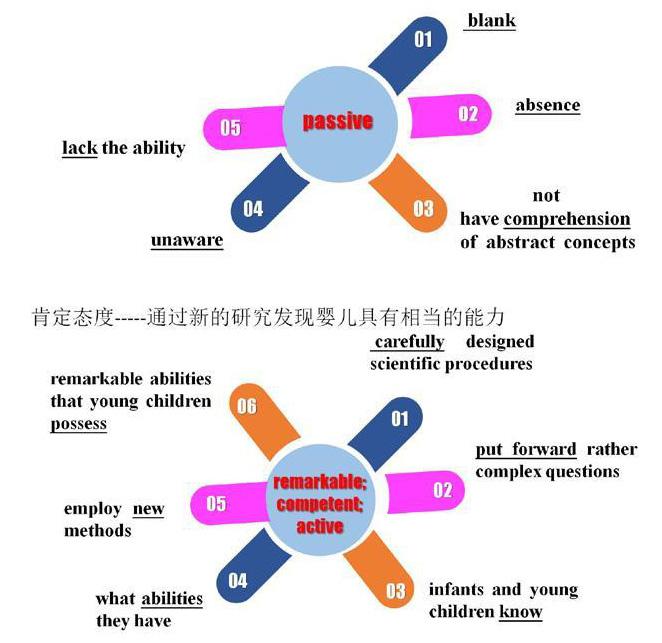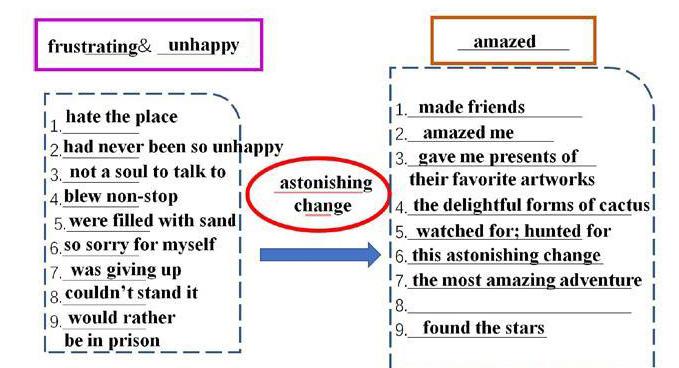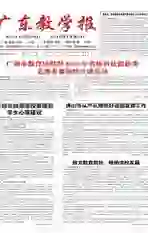“语义场”理论在高中英语完形填空教学中的应用
2020-07-06李婷
李婷


【摘要】结合一堂高中英语完形填空指导课,从生活中、语段中到语篇三个方面举例,介绍“语义场”,让学生准确理解“语义场”与完形填空解题的关系,并最终通过逆向思维,借助“语义场”理论对完整的语篇进行完形填空的设题。
【关键词】高中英语;完形填空设题;语义场;逆向思维
《普通高中英语课程标准(2017年版)》中提出了英语学习活动观,强调在语言知识的学习中增加“语篇”知识,要求培养学生依托不同类型的语篇,掌握关于语篇的微观和宏观结构,结合语篇,从语篇层面分析文章。因此,语篇分析的相关理论也成为了英语教学研究中一个日益重要的课题。与此同时,笔者在多年的高中英语教学中发现,完形填空训练中,学生的语篇意识尤为缺乏。不少学生只关注语言,搭配甚至词汇,对于涉及到上下文和语篇的题目比较难做出正确的选择。因此,笔者将尝试将语篇分析理论中的语义场理论运用于完形填空的教学中。
语义场(Semantic field)的理论可以追溯到19世纪德国语言学家特里尔,他指出:语言词汇中的词在语义上是互相联系的,共同构成了一个完整的词汇系统,词只有在“语义场”中才有“意义”。具体来说,可以理解为:第一,有些词可以在一个共同概念的支配下组成一个语义场,比如,上下义关系的词;第二,属于同一个语义场的词,在语义上相关也相互制约和规定。比如,balance与bank, account, interest等构成语义场,要确定balance的意思就需要根源根据它与这个语义场的其他词的关系入手,最终确定balance的意思是“余额”。本文中指代的“语义场“理论指的是通过词汇的使用构建表达积极态度的正面语义场和表达否定、消极态度的负面语义场。在高考完形填空中,文章多以夹叙夹议类为主,多通过词汇的运用体现了作者情感态度的体现和变化。比如,抑——扬或扬——抑——扬的语义场模式,其中“抑”指的是负面的语义场,作者会使用如“awful, hate, depressed, annoying”等词汇;“扬”指的是负面的语义场,作者会使用如“positive, happy, rewarding, useful”等的词汇。
下面结合笔者执教的一堂高中英语完形填空教学,阐述“语义场”理论在完形填空解题中的应用。课堂依托语义场理论,并启发学生通过逆向思维的方式思考完形填空的选项,从介绍语义场的定义到熟悉到运用,层层递进。
一、熟悉“语义场”的概念
1.借助图片和鲜明、熟悉的场景,以轻松而有趣的方式引入,让学生初步感知语义场的概念。
Use examples to explain what semantic field is. Offer two situations with different choices, and Ss are required to choose the one that fit in with the situation ( to attend a fancy ball; to decorate a bright and clear reading-room ). In this way, help students to realize that in order to express a certain feeling or atmosphere, certain types of items could be chosen.
2.回归教材,让学生在熟悉的文章中发现语义场,多角度理解教材的文本。同时,引导学生根据所获得的信息,提取共同特征,并对知识进行迁移,类别。
Adopt one paragraph from the text book Book 6 Unit 1 Art to demonstrate the meaning of “semantic field”, and ask Ss to analyze people's attitude towards the Impressionists and find out the clues.
(选段1) At first, many people disliked this style of painting and became very angry about it. They said that the painters were careless and their paintings were ridiculous.
(negative semantic field: dislike, very angry, careless, ridiculous)
(選段2) For a long time Gabriel didn't want to be involved in music at all. In his first years of high school, Gabriel would look pityingly at music students, struggling across the campus with their heavy instrument cases…
(negative semantic field: didn't want to be involved in music at all, pityingly at, struggling across)
(选段3)With a sinking feeling, he realized that he actually enjoyed playing the piano. He tried to hide his obvious pleasure from the music teacher, who had wandered over to listen.
(positive semantic field: a sinking feeling, enjoyed playing the piano, his obvious pleasure)
In this way, help students to realize that in order to express a certain feeling or atmosphere, certain types of expressions could be chosen.
3.在语篇中再次体会“语义场”的使用。通过对课前完成的语篇的详细解读,找到作者的用词与语义场之间的关联。
读首段,发现文章的主题是 the way children learn. 语篇类型是调查研究类, 并且提出下文两个鲜明的语义场的转化“obvious, differ from”到 “unexpected, commonalities” 的转变。
For much of the 20th century, most psychologists 43 the traditional theory that a newborns mind is a/an 44 sheet of paper upon which the record of experience is gradually impressed. During that time, scientists believed that oral 45 was necessary for abstract thought. In its 46 , scientists assumed that a baby could not have 47 of abstract concepts. As babies are born with a/an 48 range of behaviors and spend most of their early months sleeping, they certainly appear passive and 49 . Therefore, it was commonly thought that babies 50 the ability to form complex ideas. Until recently, there was no obvious way for babies to prove anything to the ___51___ to the researcher.
In time, however, challenges to this 52 arose. It became clear that with 53
designed scientific procedures, psychologists could find ways to 54 rather complex question about how much infants and young children know and what 55 they have. Psychologists began to employ new methods to 56 a large amount of data about the remarkable abilities that young children 57 . Their research findings stood in great contrast to the earlier 58 in the field that focused almost 59 on what children lacked. The 60 of young children came to life through this research. It became clear that very young children are both competent and active when it comes to their mental development.
找到語义场标志词:第二段中的passive, 表示消极的、负向的语义场;第三段中的 remarkable, competent and active, 表示正向的、积极的语义场。然后引导学生围绕核心的正向或负向语义场,寻找更多的作者用词和表达的体现,并整理成思维导图的形式。
这一环节是课堂的主体,能帮助学生清晰而全面地体会不同语义场在文章中的体现及在完形填空解题中的应用。
4.借助语义场变化明显的典型文章(课前完成并对好答案),引导学生小组合作,发现并总结语义场与文章作者的用词,描述两者之间的关系。引导学生通过比较、识别各种信息之间的关系,找到内在的关联和差异,并总结出共同特征, 提升思维品质。
二、引导学生学以致用
从出题者的角度,结合上下文,设置完形填空,并说明原因。
…When we handed him the bag of food, he lit up and thanked us with watery eyes. When I handed him the gift card (礼物卡), saying he could use it for whatever his family might need, he burst into tears…
A. sleepy B. watery C. curious D. sharp
高考完形中的选段,学生尝试将其设成完形填空的形式。对比高考的原题,让学生体会设题的成就感, 也学会从出题者的角度思考问题。在高考完形填空的完整语篇中,尝试将第一段设置成语法填空,巩固课堂所学。文章是自的完整语篇,有鲜明的语义场的变化。引导学识用总结归纳的结论解决问题,用新的视角认识问题,解决问题,提升学生的思维品质。
这节课的课堂设计巧妙,角度新颖。让学生用逆向思维,从出题者的角度了解完形填空出题的解题方法,很好地引起了学生的兴趣,学生能对完形填空形成全新的理解视角,切实提高完形的解题技能。经过课堂的学习和铺垫,不少学生最终设置的空格与高考中的设题是一致的,学生因此也受到了极大的鼓舞,感到了学习英语的成就感和满足感。
三、结语
基于“语义场”的技巧学习非常到位,笔者用了大量的素材进行说明和铺垫,从图片或图形引入,到技巧在英语中的体现,再进一步用2-3个完形中的例子进行说明和强化,最后再让学生将所学应用于实践,尝试设置完形填空的空格,由浅入深,层层递进,从而提升了学生的英语水平。
参考文献:
[1]教育部.普通高中英语课程标准(2017年版)[S].人民教育出版社.
[2]陈蓓科.利用态度信号词和逻辑信号词——把握主题语义场,巧解完形填空[J].英语教师,2019.
[3]周静.重视语篇体裁分析 突破英语教学瓶颈[J].华中农业大学学报(社会科学版),2007(1):67.
[4]刘恩祥.语义场理论在语篇中的作用试析[J].深圳信息职业技术学院学报,2004(2):1.
